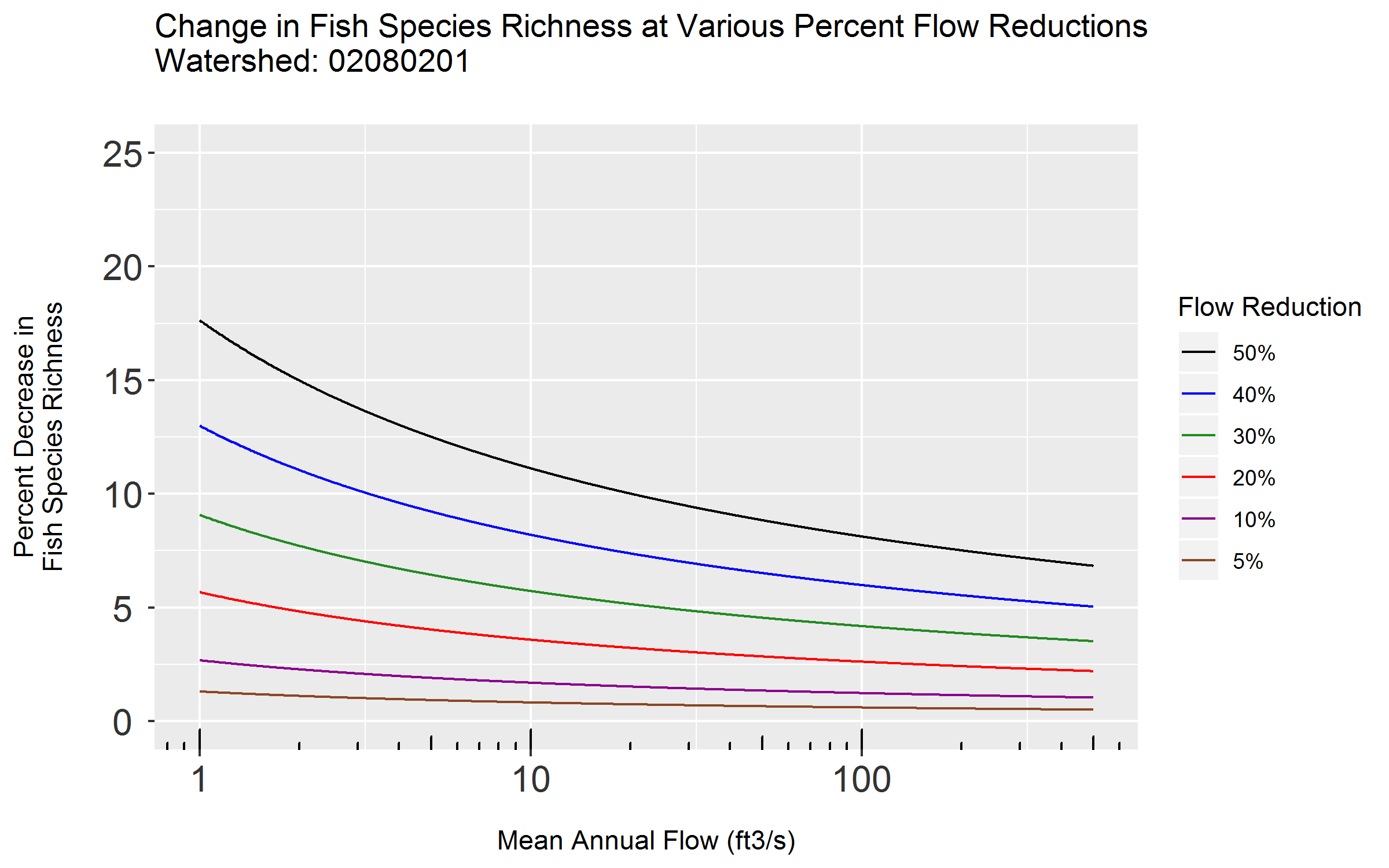

elfgen is an instream flow framework for rapid generation and optimization of flow-ecology relations. The elfgen framework centers on the generation of Ecological Limit Function models (ELFs) describing the relation between maximum species richness and stream size characteristic (streamflow or drainage area). The elfgen framework was developed (By DEQ in cooperation with USGS and Virginia Tech) in response to a need for better environmental flow metrics for assesment of potential impacts of water use. For the first time this new framework may allow quantification of potential species loss resulting from flow change, and may offer an improved understanding of aquatic life risk variability due to geographic location, stream size and local scale.
Supporting manuscripts have been published in the Journal of the American Water Resources Association (JAWRA): - elfgen: A New Instream Flow Framework for Rapid Generation and Optimization of Flow–Ecology Relations. - Kleiner et al. (2020): https://onlinelibrary.wiley.com/doi/full/10.1111/1752-1688.12876 - Application of a New Species-Richness Based Flow Ecology Framework for Assessing Flow Reduction Effects on Aquatic Communities - Rapp et al. (2020): https://onlinelibrary.wiley.com/doi/full/10.1111/1752-1688.12877
# Install the current released version from CRAN:
install.packages("elfgen")
# Or install the development version from Github:
# install.packages("devtools")
devtools::install_github("HARPgroup/elfgen")An introductory example of how elfgen works is supplied below. You
start by either supplying a dataset with flow and richness data, or by
supplying a HUC code of interest. When supplying a HUC code:
elfdata() will retieve IchthyMaps data from USGS
ScienceBase using the sbtools package and automatically
derive fish species richness at the NHDPlusV2 segment scale. Mean annual
flow data is then automatically retrieved for each NHDPlusV2 segment
using the nhdplusTools package.
A breakpoint in the flow-ecology relation is determined using a fixed
user-defined value, or identified using the functions
bkpt_pwit() or bkpt_ymax(). The ELF model is
then generated and plotted using elfgen() with ELF model
statistics returned.
Additional richness change analyses may be performed using the
functions richness_change() and elfchange()
(See below)
library(elfgen)
# Retrieve dataset of interest
# You may enter either a 6, 8, 10, or 12-digit HUC code
# *Notes:
# By default the ichthy dataset is downloaded to a temp directory, however this may be overridden by
# supplying a local path of interest using the input parameter "ichthy.localpath"
# 6-digit HUCs like the following example may take a few minutes to process with elfdata() due to the
# large number of contained IchthyMaps historical stream fish distribution data
watershed.df <- elfdata(watershed.code = '02080201', ichthy.localpath = tempdir())# Alternatively, utilize a user-supplied dataset in the following format:
watershed.df <- data.frame(flow=c(28.257, 20.254, 22.825, ...),
richness=c(2, 10, 12, ...),
watershed='02080201',
stringsAsFactors=FALSE) "quantile" for
isolating an upper subset of the data. A user also identifies a bounding
range between two x-values ("blo" = “bound low”,
"bhi" = “bound high”) in which the upper subest of data is
believed to contain a breakpoint. (Note: Small datasets may not contain
a breakpoint)# Fixed Method
breakpt <- 500
# Piecewise Iterative Method
breakpt <- bkpt_pwit("watershed.df" = watershed.df, "quantile" = 0.95, "blo" = 200, "bhi" = 500)
#> [1] "Breakpoint identified at 310.815"
# Ymax Method
breakpt <- bkpt_ymax("watershed.df" = watershed.df)
#> [1] "Breakpoint identified at 142.989""quantile" for isolating the upper
subset of the data. The breakpoint "breakpt" determined
using one of the above methods is passed in. "yaxis_thresh"
is used to customize the maximum y-axis limit. Custom x-axis and y-axis
plot labels can be specified using "xlabel" and
"ylabel" respectively.elf <- elfgen("watershed.df" = watershed.df,
"quantile" = 0.95,
"breakpt" = breakpt,
"yaxis_thresh" = 53,
"xlabel" = "Mean Annual Flow (ft3/s)",
"ylabel" = "Fish Species Richness")elf$plot
elf$stats
#> watershed breakpt quantile m b rsquared rsquared_adj p n_total n_subset n_subset_upper
#> 1 02080201 142.989 0.95 2.34 9.19 0.806 0.8 0 861 705 35richness_change() and input the percent reduction in flow
"pctchg" (10 = 10% reduction in flow)"xval"
parameter is supplied, the function will calculate the percent change in
richness at a specific stream size (For this example 50 = a stream size
with mean annual flow of 50 cfs)# Calculate absolute richness change (resulting from flow reduction)
richness_change(elf$stats, "pctchg" = 10)
#> [1] "Absolute Richness Change:"
#> [1] -0.2465436
# Calculate percent richness change at a specific stream size
richness_change(elf$stats, "pctchg" = 10, "xval" = 50)
#> [1] "Percent Richness Change at x = 50:"
#> [1] -1.343992elfchange(). "yaxis_thresh" is used to
customize the maximum y-axis limit. Custom x-axis and y-axis plot labels
can be specified using "xlabel" and "ylabel"
respectively.# Generate plot of percent richness change for various percent flow reductions
elfchange(elf$stats, "yaxis_thresh" = 25)